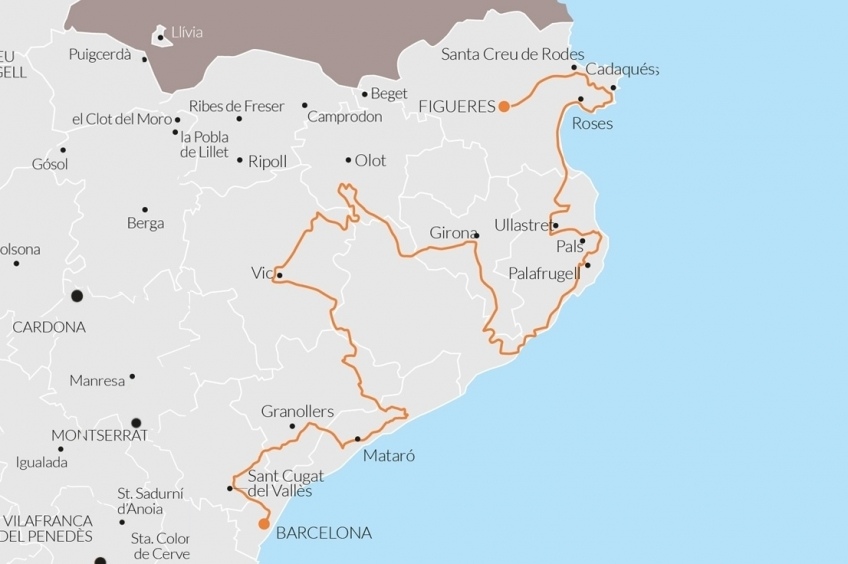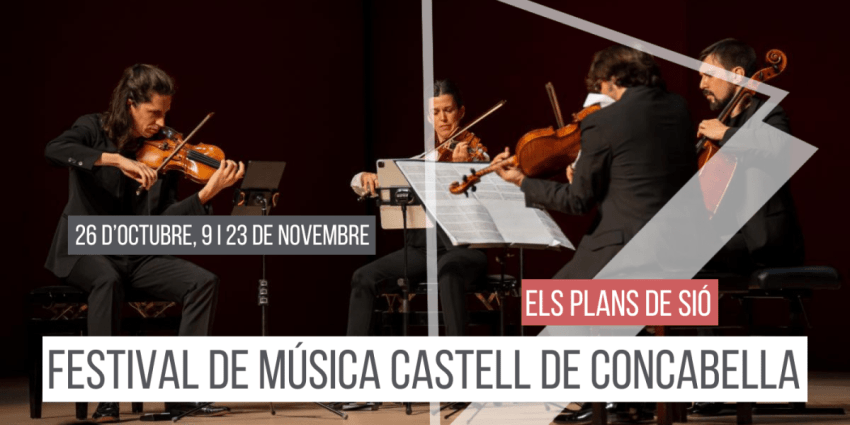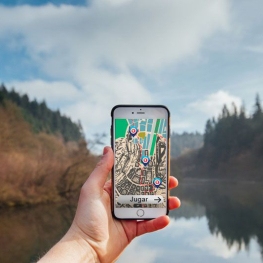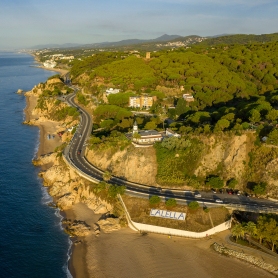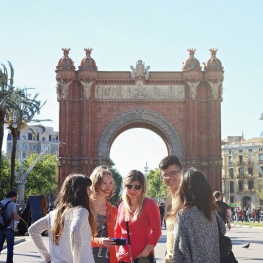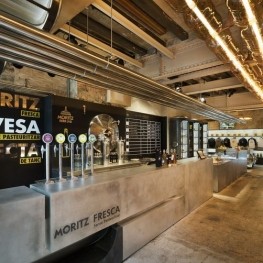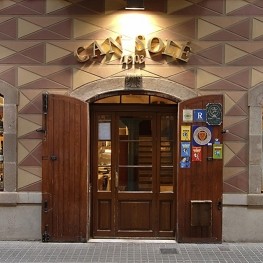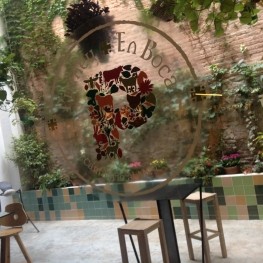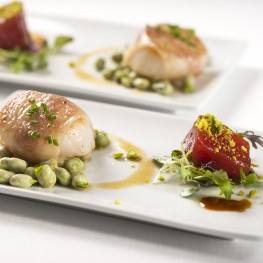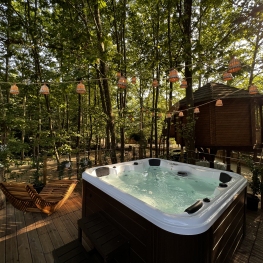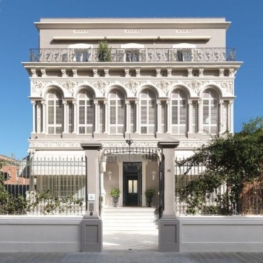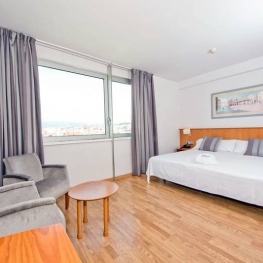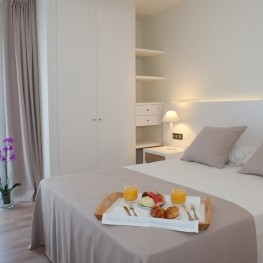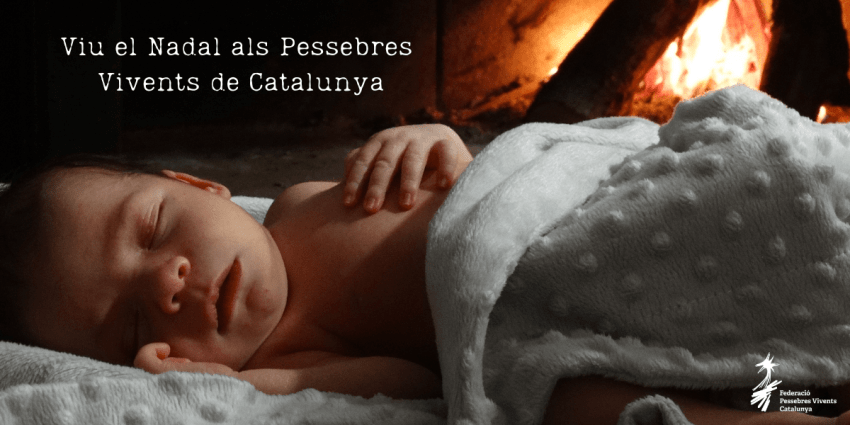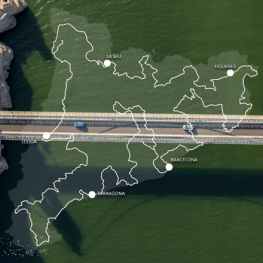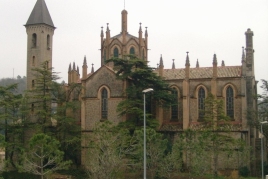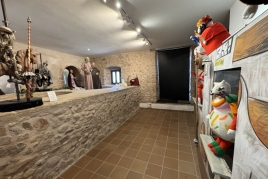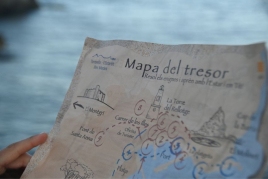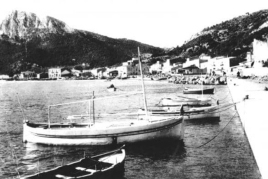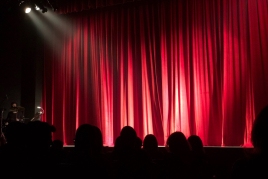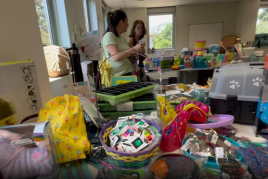Grand Tour de Catalunya - Section 5. From Surrealism to Modernism. From Figueres to Barcelona
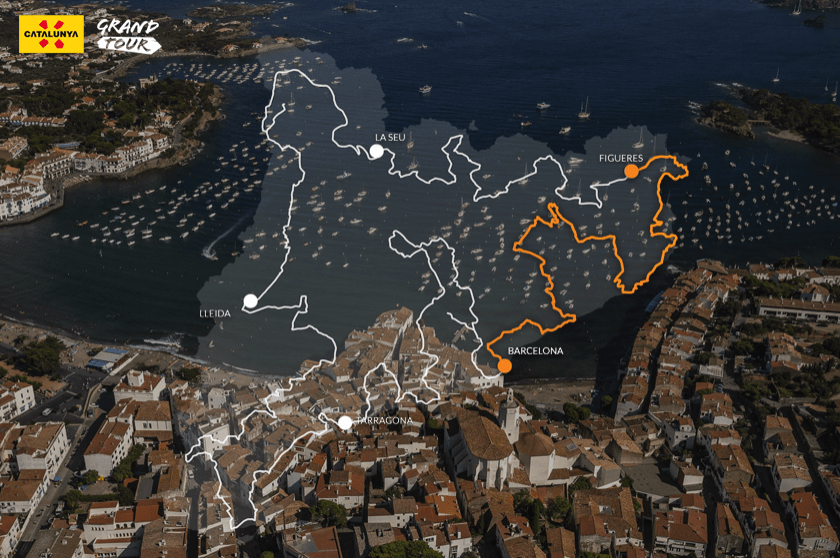
This route is designed to be done by electric vehicle, although it can be done with any other car. Along the route we will suggest municipalities that have charging points and places of interest to visit while we charge batteries.
Electric cars are a good way to decarbonise road transport These vehicles do not emit greenhouse gases and do not need fossil fuels to run, which which makes them a viable option to help reduce our CO₂ footprint.The constant improvement in the technology of these cars makes them increasingly efficient and ecological.
Consult also the recommendations when traveling by electric car.
7
Number of sections
525
Total kilometers
The Grand Tour de Catalunya is a journey full of travels. This circular route, inspired by the great journeys that the young people of the 17th century bourgeoisie made through Europe, proposes a rediscovery of the territory beyond the main icons of our land, so that you can enjoy its purest essence through the unique landscapes that it gives us, a unique identity and cultural heritage and a gastronomy that will make your taste buds vibrate.
The Grand Tour of Catalonia, which covers more than two thousand kilometers, is not designed to be done in a single run, unless you are one of the lucky few who in our current busy world, and have almost more than a month to be able to do it. For this reason, this route offers you 5 different sections divided into several stages, where each stage is equivalent to one day. In this way, each traveler can organize the route to their liking, travel it at their own pace and at any time of the year.
The last stage will take you back to the sea on a journey that runs from the capital of surrealism, Figueres, to the capital of modernism, Barcelona, over 7 stages and 525 kilometers .
Along the way, one will enter through the Costa Brava in seaside and bohemian towns such as Cadaqués and will have the opportunity to cross some of the most beautiful stretches of Caminos de Ronda, pure Mediterranean essence. The sea will not be the only postcard image of the section, since you will meet again with the medieval villages, this time those of the Empordanet. For mountain lovers, the Montseny Natural Park is presented as a gift with beautiful trails and routes. On the way to Barcelona, you will enjoy the family beaches of the Maresme and the Indian architecture, the gastronomy of Vic, the DO Alella wine and other delicatessen for the palate.
Read on for more details on the last stage of the Grand Tour de Catalunya.
You cannot miss :
- Figueres
- Natural Park of Cabo de Creus, Cadaqués and Portlligat
- Inland medieval villages
- Girona
- Vic
- Montseny Natural Park
- Barcelona coast: modernism and Indian villages
- Barcelona
Route's villages
Stage 1: Dalí's Empordà
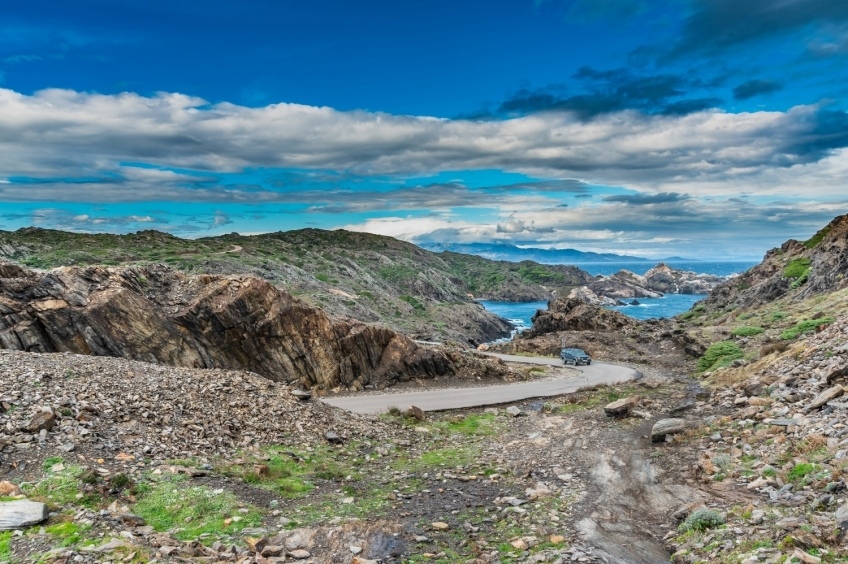
37 KM (Monestir de Sant Pere de Rodes)![]()
Next stops
![]() 22 KM (Portlligat)
22 KM (Portlligat)![]() 3 KM (Cadaqués)
3 KM (Cadaqués)![]() 46 KM (Empúries)
46 KM (Empúries)![]() 5 KM (l'Escala)
5 KM (l'Escala)
The stage begins in the hometown of Dalí, the genius with the sublime mustaches, so there is no plan that does not include a visit to the Dalí Theater Museum , an authentic surrealist monument in itself. We recommend a guided tour to delve into the genius of the artist's mind and not miss details of all the trompe l'oeils, visual resources, metaphors and symbols that his works hide. After the visit, you can also visit the Toy Museum , where you can find toys from the genius's childhood and the Empordà Museum , a museum dedicated to the culture of the area.
Did you know that there are two other Dalí museums? Crossing and advancing along the roads of the Cap de Creus Natural Park , you will arrive at Cadaqués , one of the most beautiful and iconic towns on the Catalan coast and the stopping point of the stage where the Casa de Portlligat is located, the house that Dalí turned into his workshop and a meeting point for many of the artists and intellectuals of the time . In Púbol, stands the Castle that Dalí gave to his wife and muse, Gala . The route that connects these three museums is called the Dalinian Triangle .
Driving between vineyards of the denomination of origin (DO) Empordà , hit by the tramontana, extending from the Pyrenees to the Mediterranean, you will arrive at the monastery of Sant Pere de Rodes , where you will learn the close relationship that this territory has with the wine tradition and the monks who inhabited the monastery. From the viewpoint, you can see how the Pyrenees merge with the sea and a beautiful panoramic view of Cap de Creus and Port de la Selva.
After visiting the monastery, the house of Portlligat de Dalí and Cadaqués, you will head towards the ruins of Empúries , where the Greeks and Romans entered the Peninsula and built one of the most prosperous and important towns of the time in what which refers to the wine trade.
To end the day, in L'Escala , a town with a seafaring tradition, the Anchovy and Salt Museum is a mandatory stop to discover the work of the salting factories and taste the well-known anchovies of L'Escala .
![]()
Need to recharge?
Llançà (22 Km)
Meanwhile... Stroll through the old town and discover the Church of Sant Vicenç and the Romanesque Tower, testaments to a history-filled past. If you prefer the sea, head to Grifeu Beach, one of the most iconic and visited in the area. If you have more time, immerse yourself in its seafaring essence with a wine tasting aboard a traditional sailing boat as you sail around Cap de Creus – an experience to enjoy the region with all your senses.
Port de la Selva (9 Km)
Meanwhile... Stroll through the old town and breathe in the tranquil atmosphere of a seaside port, whilst admiring the combination of the Mediterranean and the cliffs of Cap de Creus, a spectacular and unspoilt natural setting. If you have more time, take the opportunity to immerse yourself in other activities: explore the hiking trails in the Cap de Creus Natural Park, enjoy the marine life with snorkelling or kayaking, and savour the local cuisine: grilled octopus, locally caught prawns and seafood paellas will provide you with an experience of flavour and authenticity.
Cadaqués (13 Km from Port de la Selva)
Roses (17 Km)
![]() Carrer de la Riera Ginjolers, 68
Carrer de la Riera Ginjolers, 68
And in the meantime... While the car is charging, take a stroll and discover one of the most beautiful bays in the world. Sit on a terrace and savour the Mediterranean essence and the seafaring tradition of this welcoming village. For the more adventurous, the walking route to Puig de l'Àliga (463 metres) will take you to admire the Bay of Roses from a spectacular vantage point.
Sant Pere Pescador (17 Km)
Meanwhile... The charging stations in Sant Pere Pescador are located at Camping Aquarius, a little way from the town centre, so take the opportunity to stay close to the sea. Sant Pere Pescador offers you an unspoilt beach of fine sand with shallow dunes and 6.3 km of coastline for a stroll. If you're looking for more excitement, try windsurfing, kitesurfing, sailing, catamaran, kayaking, beach volleyball, or paddleboarding. And for a unique experience, discover Ornitokayak, an ornithological activity that combines birdwatching with kayaking.
L'Escala (19 Km)
![]()
Next stops
27 KM (Peratallada)
![]() 3 KM (Palau-sator)
3 KM (Palau-sator)
![]() 15 KM (Begur)
15 KM (Begur)
![]() 9 KM (Palafrugell)
9 KM (Palafrugell)
![]() 10 KM (Palamós)
10 KM (Palamós)
Stage 2: A trip to the Middle Ages
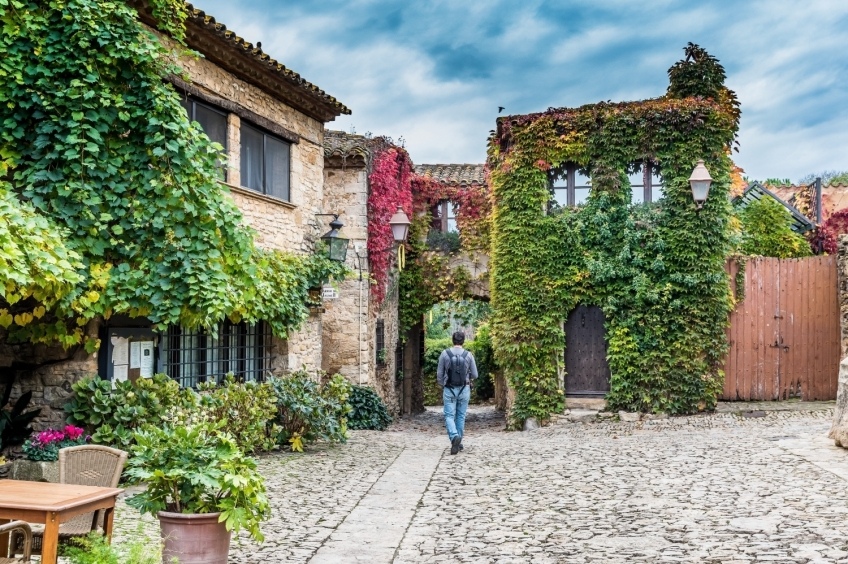
The day rises in the second stage of the section. This stage will immerse you fully into the ampurdanesa essence through the character of its villages, medieval towns and fishing villages along 72 kilometers that will take you from Pals to Tossa de Mar.
With Montgrí and its castle at the top behind you, you will approach L'Estartit, from where you can embark to visit the Iles Medes, a Mediterranean paradise for diving enthusiasts . Afterwards, the Grand Tour offers you an exciting journey into the past through the medieval towns of the Empordanet: Ullastret, Peratallada, Monells, Pals, etc. and the best way to do it is on two wheels, so wear comfortable clothes to go out on an e-bike. You will be located in the land of the Manzana de Girona, a product with Protected Geographical Indication (PGI) , so you are morally obliged to visit a local cider house to taste this delicious elixir and other products derived from the apple. Then, embarking on the route again, you will move back to the shore of the Mediterranean to discover the beauty of the coves of Begur and Calella de Palafrugell . Do you already know which writer used to spend the summer on Canadell beach?
You will end the day in Palamós , where the best way to get into the local seafaring tradition is through traditional recipes in a 'boat cooking' workshop, where you will learn to prepare the dishes that the sailors and fishermen prepared on board the boats. boats when they went fishing. Products as emblematic as the prawn from Palamós and the rice from Pals will not be missing from the list of ingredients .
Next, you will have the privilege of being able to see the arrival of the fishermen to port and see how the fish auction takes place. Before ending the day, wine is the best pairing for fish, so a stop at the Brugarol winery to taste several DO Empordà wines is the best option. Oh, and don't forget to enjoy the winery's architecture! It has been designed by the prestigious and award-winning architecture studio RCR. A feast for the eyes .
To finish the stage, head towards Tossa de Mar, where you can spend the night.
![]()
Need to recharge?
Torroella de Montgrí (14 Km)
Meanwhile... As with most villages in the Empordà region, the old quarter of Torroella de Montgrí will captivate you with its town square, arcades and medieval atmosphere. Step inside the Church of Sant Genís and take a cultural visit to the Museum of the Mediterranean or to Palau Solterra, a centre for contemporary photography. If you have the energy, put on your walking boots and head for the summit of the Montgrí massif; from the castle, the views will take your breath away, combining sea, mountain and plain. And if you're drawn to nature, explore the Montgrí, Medes Islands and Baix Ter Natural Park, with its hidden coves, marshes and paths that cross a truly extraordinary landscape.
Begur (31 Km from Torroella de Montgrí)
![]() Carretera de Circumval·lació, sn
Carretera de Circumval·lació, sn
Palafrugell
Palamós
![]()
Next stops
36 KM (Tossa de Mar)
![]() 12 KM (Lloret de Mar)
12 KM (Lloret de Mar)
![]() 6 KM (Blanes)
6 KM (Blanes)
![]() 54 KM (Girona)
54 KM (Girona)
![]() 48 KM (Hostalets d'en Bas)
48 KM (Hostalets d'en Bas)
Stage 3: Coastline of the Costa Brava
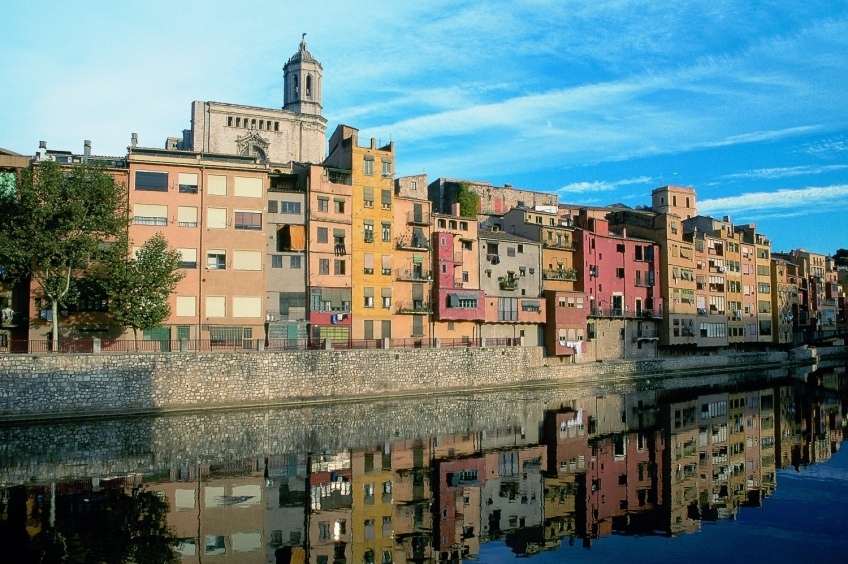
In this third stage, you will dedicate the morning to the towns in the south of the Costa Brava, visiting majestic gardens hanging over the sea. Then you will head to the City with Character of Girona and finish the 90 kilometers of this stage in the picturesque town of Hostalets d'en Bas.
The panoramic view of the Villa Vella de Tossa de Mar is one of the Costa Brava postcards, with the wall surrounding the fishing district of Sa Roqueta. Let yourself get lost between the wall and the narrow streets, authentic balconies on the Mediterranean that will offer you beautiful landscapes of the sea. After the visit to the Vila Vella, the Grand Tour proposes you tour one of the most beautiful stretches of all walks of Ronda, specifically the section between Sant Feliu de Guixols and Tossa de Mar.
The next stop of the stage takes you to enjoy the rest of the morning and noon in Girona . Before that, make a short detour to Lloret de Mar , where both the beauty of the Santa Clotilde Gardens and the imposing views of the sea will steal your heart. The landscape from the stairway guarded by two mermaids is unique! And if by chance, you are passionate about the world of botany, in Blanes you will find another important garden, that of Marimurtra .
Once in the city of Girona, a gastronomic visit is the best option to get to know the city, since in addition to stopping at the most important points of the heritage, you will be able to experience and taste the typical flavors of the area: the xuixos, the ice creams of the Roca brothers, donuts, local cheeses and liquors , etc.
In the afternoon, golf lovers can take a break to play a few holes at one of the best golf courses in Europe, the PGA Catalunya Resort . Then, you will head towards the lands of the Pre-Pyrenees, specifically in the Garrotxa region again, this time to get to know one of the most picturesque and beautiful villages in the area, Hostalets d'en Bas .
![]()
Need to recharge?
Sant Feliu de Guíxols (15 Km)
Meanwhile... While the car is charging, enjoy the beach and the Passeig del Mar, an ideal spot to breathe in the Mediterranean air and gaze upon the coves surrounding the village. Stroll through the old town and discover the Market Square, the old abbey with the Porta Ferrada, the Fum and Corn towers, and visit the History Museum, which will connect you with the town's past. If you fancy it, head up to the Hermitage of Sant Elm to enjoy unforgettable views over the bay, gaze upon the Pedralta – the swinging rock that marks the border with the Vall d'Aro – or indulge in outdoor activities such as the Cala del Molí coastal via ferrata, kayaking, diving and coastal footpaths, all while discovering the beauty and authenticity of this Mediterranean corner.
Tossa de Mar (23 Km from Sant Feliu de Guíxols)
Lloret de Mar
Blanes
Cassà de la Selva (28 Km from Tossa de Mar)
Meanwhile... Cassà de la Selva is a town with a long tradition of cork-making that shapes its identity and history. Don't miss the Cork Route, an urban itinerary that will allow you to learn about the importance of this industry and discover the town's most emblematic corners. Next, take a stroll through the old town and visit the Church of Sant Martí, the town square and the High Street, with its modernist houses, a testament to its industrial past. If you prefer nature, you can venture into the fields of Esclet, a protected area ideal for birdwatching and enjoying the tranquillity of the landscape.
Girona (13 Km from Cassà de la Selva)
Amer (25 Km)
Meanwhile... Amer is a village rich in medieval history, surrounded by a tranquil and welcoming natural setting. Stroll through the old town and discover the Church of Santa Maria, the Plaza de la Vila with its arcades, and the Torre de Rocasalva, all testaments to the village's past. Immerse yourself in nature in the surroundings of the Amer valley, with its chestnut, hazelnut and pine forests, ideal for outdoor activities such as hiking and birdwatching. Don't forget to visit the Font Picant, a natural spring of volcanic carbonated water, located near the village.
La Vall d'en Bas (23 Km from Amer)
![]()
Next stops
21 KM (Rupit)
![]() 12 KM (Tavertet)
12 KM (Tavertet)
![]() 30 KM (Manlleu)
30 KM (Manlleu)
![]() 10 KM (Vic)
10 KM (Vic)
![]() 29 KM (Viladrau)
29 KM (Viladrau)
Stage 4: Hiking in the Montseny
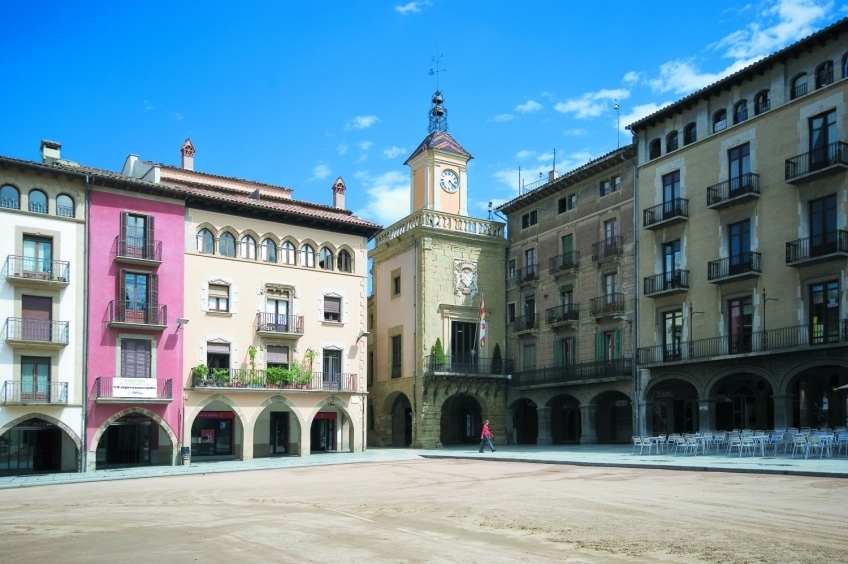
The first stop of the day is in one of the Charming Villages, Rupit , with its iconic set of stone houses in the middle of the Collsacabra, a natural landscape of mountains with vertiginous cliffs, streams and waterfalls . At the Rupit tourist office you can hire a visit to delve into the history of this town grown under the shelter of a huge rock where one day there was a castle.
Next, you will head to Tavertet to make an excursion that will allow you to get spectacular views of the cliffs that take the name of the town and the Sau reservoir, one of the reservoirs of the Ter River at the foot of the Les Guilleries mountain range, surrounded by exotic pine and fir forests. Already in Manlleu , the next stop of this stage, you will discover the industrial past marked by the river Ter through a theatrical visit.
You will continue the route on the way to Vic . Its Plaza Mayor is one of the most emblematic of the Catalan regions , a monumental porticoed square that is always very lively, especially during the weekly market. Thanks to the guided tour of the city, in which you will have the opportunity to discover its Roman temple, the cathedral and the streets that were part of the Jewish quarter, you will be able to enter a centenary dryer to taste the sausages that have made Vic famous, the fuet and llonganissa .
In the afternoon, the Grand Tour proposes you to discover and delve into the local folklore and learn about the legends of witches and bandits that surround the Montseny Natural Park, a place declared a Biosphere Reserve . The best way to do it is undoubtedly putting on your hiking boots and doing a circular route in which you will find majestic redwoods, firs, beech and oak trees that seem to have been taken from a fairy tale. Later, if you are interested in learning more about the relief of the area, you can visit the Espai Montseny de Viladrau , the park's interpretation center.
![]()
Need to recharge?
Rupit
Tavertet
L'Esquirol (12 Km)
Meanwhile... L'Esquirol, the gateway to the magical Collsacabra mountain range, is a place where you can breathe in nature and history. Stroll through the old town and discover the village's origins in the 15th century by visiting the local church. Once you've explored the town, get ready to go for a walk! You can opt to take part in guided tours, such as “Immersion in the Forests of Collsacabra”, where you'll discover majestic beech forests, centuries-old oak trees and a birch grove amongst ferns, or the “Contemplative Route of the Cliffs of Collsacabra”, which offers landscapes to be enjoyed with all the senses. If you'd rather go it alone, walk to the Foradada or the Barra de Ferro, spectacular gorges formed by the Riera de les Gorgues, with waterfalls and settings of complete natural freedom.
Manlleu (11 Km from L'Esquirol)
![]() Carrer Torrent de la Borina, 1
Carrer Torrent de la Borina, 1
Vic
Viladrau
Sant Hilari Sacalm (19 Km from Viladrau)
Meanwhile... Start with a stroll through the Guilleries Museum, which introduces you to the area's natural wealth and its traditional crafts. Head into the centre to discover the church of Saint Hilary of Poitiers, with its Romanesque and Gothic design, and be amazed by the AQUA Centre, where mineral water reveals its importance in the life of the town. Immerse yourself in the natural beauty of the Guilleries with a walk to the Miranda or Pla de Campaner viewpoints, visit the former spa at the Font Picant with its mineral-medicinal waters, and the Centre Artesà de la Torneria to understand a living artisan tradition.
![]()
Next stops
62 KM (Sant Pol de Mar)
![]() 6 KM (Canet de Mar)
6 KM (Canet de Mar)
![]() 4 KM (Arenys de Mar)
4 KM (Arenys de Mar)
![]() 30 KM (Alella)
30 KM (Alella)
![]() 27 KM (La Roca Village)
27 KM (La Roca Village)
![]() 14 KM (Circuit Barcelona-Catalunya)
14 KM (Circuit Barcelona-Catalunya)
![]() 40 KM (Barcelona)
40 KM (Barcelona)
Stage 5: The modernist Maresme
The modernist heritage of the coastal towns of the Maresme is the prelude to your arrival in Barcelona, in the 154 kilometers that await you ahead, not without first stopping in Alella to taste some wines that were already produced in Roman times.
Going down the mountains of the Vallès Oriental, you will reach the Maresme coastline, characterized by fine sand. In Sant Pol de Mar , let time pass and relax contemplating the calm sea. The rest of the morning can be dedicated to touring the different towns along the coast to discover the modernist heritage of the area. In Canet de Mar , you can visit the house of Domènech i Montaner and taste the modernist stained glass windows, some typical tea pastries of the city, or in Arenys de Mar the Sinera cemetery and in Mataró the Casa Coll y Regàs and the Nau Gaudí , the first work of the architect, they are also very good cultural options.
In the afternoon, let yourself be delighted with an organic rosé cava from DO Alella , which pairs perfectly with the Vallalta strawberries .
On the way to Barcelona, if what you are looking for is to download adrenaline, in the Catalunya circuit you can enjoy various experiences related to the world of speed, or if what you prefer is to enjoy an afternoon of shopping, in La Roca Village you will find more 140 stores of the main national and international boutiques.
![]()
Need to recharge?
Sant Celoni (38 km)
Meanwhile... Wander through the old town, and be captivated by the Town Square and Can Ramis, before approaching the Church of Sant Martí. Continue to the Old Rectory and walk along the Pertegàs Promenade, feeling the town's past still pulsating through its streets. For nature lovers, the Vall d'Olzinelles, the Pou de Glaç, the Maribaus and the Llobateres areas offer paths surrounded by greenery, and the Tourdera (Tordera) Route invites you to walk through landscapes that breathe life all year round.
Sant Pol de Mar (25 Km from Sant Celoni)
![]() Carrer de la Carretera Nacional Ii
Carrer de la Carretera Nacional Ii
Canet de Mar
Arenys de Mar
Mataró (17 km)
![]() Plaça Francisco Tomàs y Valiente, 1
Plaça Francisco Tomàs y Valiente, 1
Meanwhile... Getting lost in the streets of Mataró's town centre is quite an experience: you'll discover architectural gems such as the Nau Gaudí, the first building designed by Antoni Gaudí; Casa Coll i Regàs and the Rengle market, the work of Josep Puig i Cadafalch; or the Dolors Chapel in the Basilica of Santa Maria, with paintings by Antoni Viladomat. And if you want to delve deeper into Modernisme, be sure to take a guided tour of Casa Coll i Regàs. For the more active, the Bosc Vertical offers adventure courses among the trees with over 90 activities to choose from for all ages. And if you prefer the sea, set sail from the harbour and cruise along the seafront, where you can enjoy a swim and a talk about the coastline's morphology and the local marine life.
Alella (16 Km from Mataró)
![]() Carrer de la Riera Principal, 16
Carrer de la Riera Principal, 16
La Roca Village – La Roca del Vallès (22 Km from Mataró)
Circuit de Barcelona-Catalunya – Montmeló
Sant Cugat del Vallès (21 Km)
![]() Av. Lluís Companys i Jover, 31
Av. Lluís Companys i Jover, 31
Meanwhile... A visit to the Monastery is almost compulsory: discover the monumental complex and the Romanesque cloister through the tours ‘Hearing the Voice of the Monastery' and ‘Medieval Stone Book'. Complement this with a stroll through the city's most emblematic green spaces, such as the urban boulevard and the gardens, which are designed according to sustainable criteria, using native species to enhance biodiversity and reduce water consumption. Immerse yourself in the city's winemaking past by visiting the Modernista Cellar, the work of Cèsar Martinell and now a museum with guided tours, and the new VILAB, a wine interpretation centre that combines reality and sensory experience. Afterwards, immerse yourself in the city's creative spirit at Mercantic, a vintage village full of antique shops, a second-hand bookshop, live music and crafts, and round off your visit with a fascinating tour of the Comic Museum, which traces 135 years of the ever-evolving world of comics.
Barcelona (18 Km from Sant Cugat del Vallès)
Stage 6: An appointment with Gaudí
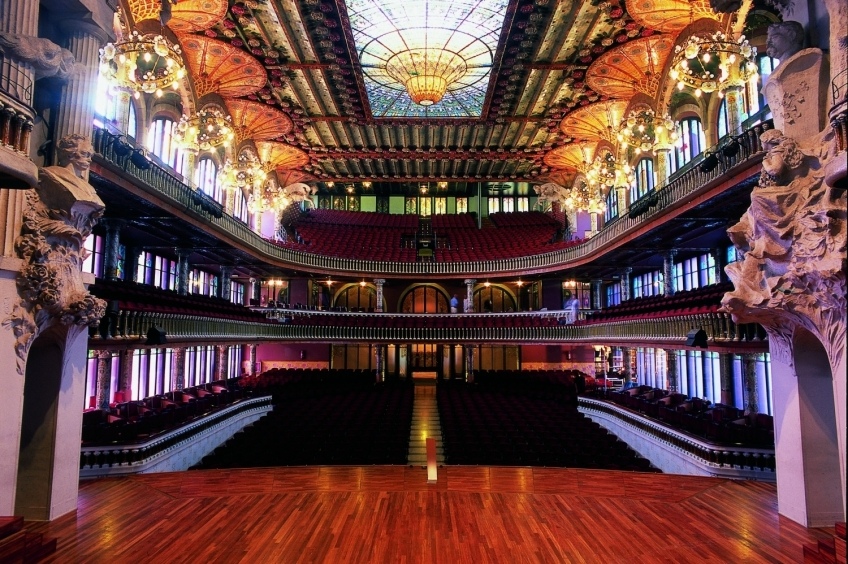
The best modernist buildings by Gaudí and Domènech i Montaner, trencadís crafts, the most traditional Catalan cuisine and a literary walk through the Born district complete your first day in Barcelona.
Begin the stage with a guided tour that will follow in the footsteps of the Barcelona Modernism Route, which runs through 120 buildings with works as important as Gaudí or Domènech and Montaner: Casa Batlló, La Pedrera, Casa Vicenç, the Modernist Site Sant Pau or the Palau de la Música Catalana are some of the icons of this trend. After the visit, you will continue with your immersion in modernism with a workshop to learn trencadís , an ornamental technique characteristic of modernism. With some basic tools and pieces of ceramic and glass, you will come up with your own elaborate piece and great ideas for recycling construction materials!
At noon, you will be able to participate in a traditional Catalan cooking workshop, and with a full belly, you will set off on a literary route to visit the stages of pieces such as La sombra del viento or La catedral del mar. At night, enjoy the bustle of the city with some tapas and a good glass of wine.
Stage 7: The sea of Barcelona
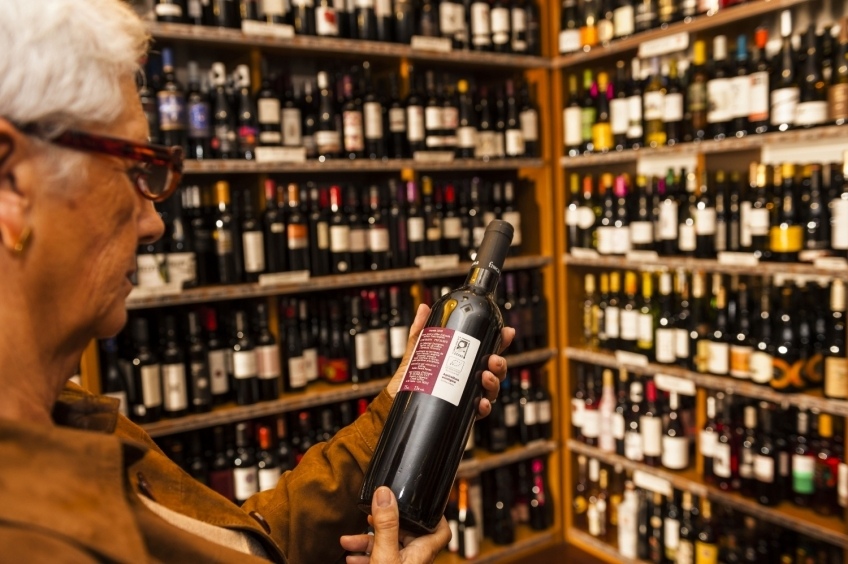
The last stage to finish the Grand Tour is dedicated to the sea of Barcelona and the products that are extracted from it.
The best way to enjoy the essence of any town or city is by visiting the markets with local products, and Barcelona's market network is one of the largest in the world with more than 40 markets. With the carrycot in hand and with the help of a local guide, you will enter the stalls to get the freshest and best products and then be able to prepare a good rice. Write down all the steps of the recipe well to be able to succeed when you cook it at home for your friends and family!
In the afternoon, you can visit the fishermen's brotherhood, see the arrival of fishermen to port and discover how a traditional activity such as fishing has survived in a large metropolis, being able to serve all the demand of the city.
To put an end to the Tour and the stage, you will board a catamaran to close with a golden key this wonderful route that will have shown you the essence of Catalonia. A good swim in the Mediterranean, an aperitif and a glass of cava watching the sun set behind the Collserola mountains is, without a doubt, the best way to finish.
Encourage us to visit the Grand Tour of Catalonia, enjoy the essence of our land in all its splendor like never before. For more information visit https://grandtour.catalunya.com/en/ and if you dare to do it by electric car, visit https://grandtour.catalunya.com/ca/cotxe-electric/
Text and images Grand Tour de Catalunya.
What to do
Gymkana Digital Turística
BarcelonaTourist and cultural routes in a gymkhana format. Completely free and without…
Gimcanes GeoCats
BarcelonaDiscover Barcelona with GeoCats in the most convenient and fun way possible!…
Where to eat
Fàbrica Moritz Barcelona
Barcelona (a 1.3 Km)The Moritz Factory Barcelona is a unique space, divided into three floors,…
Restaurant Windsor
Barcelona (a 2.2 Km)The Windsor restaurant, located in Barcelona, is a benchmark of contemporary Catalan…
Where to sleep
Càmping l'Alguer
Les Planes d'Hostoles (a 7.8 Km)The Alguer campsite seeks to give the best for you, since it…
Aparhotel Atenea Vallès
Granollers (a 14.8 Km)The Atenea Valles Aparthotel Granollers is located in the commercial center of…
Related routes
Grand Tour de Catalunya - Section 3. Heaven is very close. From Lleida to La Seu d'Urgell
I want to do this route by electric vehicle! This route is designed…

